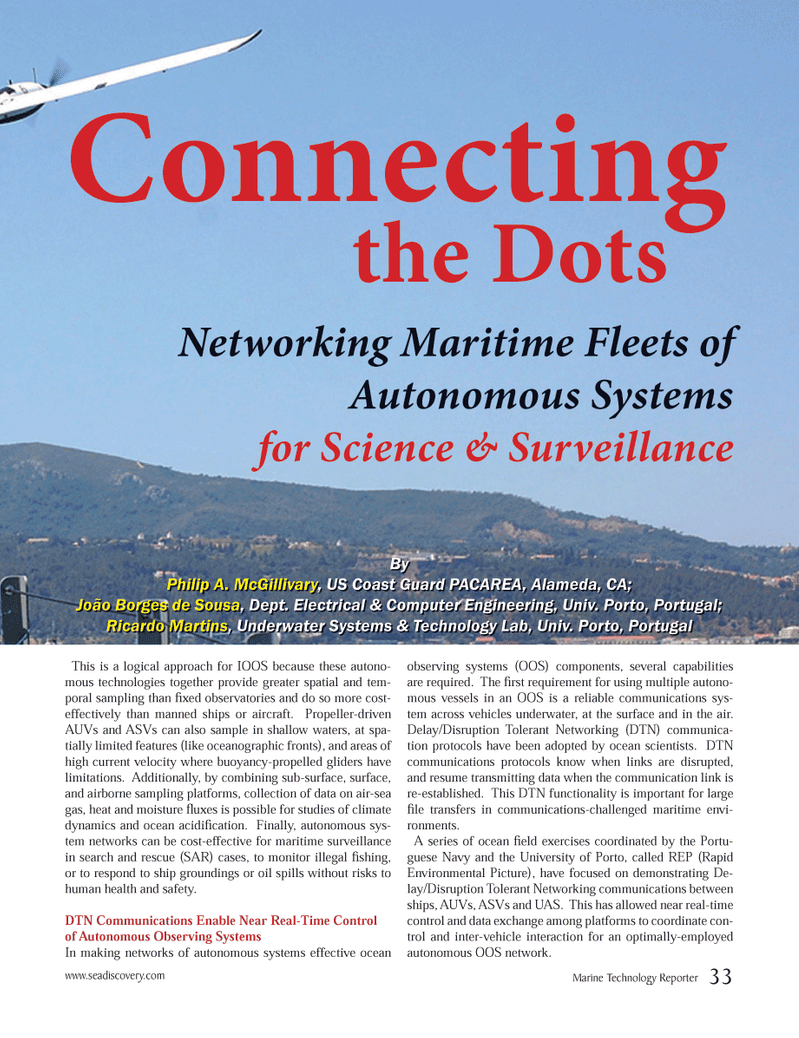
Page 33: of Marine Technology Magazine (October 2012)
Ocean Observation: Gliders, buoys & sub surface monitoring networks
Read this page in Pdf, Flash or Html5 edition of October 2012 Marine Technology Magazine
Networking Maritime Fleets of Autonomous Systems for Science & Surveillance By Philip A. McGillivary, US Coast Guard PACAREA, Alameda, CA; João Borges de Sousa, Dept. Electrical & Computer Engineering, Univ. Porto, Portugal; Ricardo Martins, Underwater Systems & Technology Lab, Univ. Porto, Portugal This is a logical approach for IOOS because these autono-mous technologies together provide greater spatial and tem- poral sampling than Þ xed observatories and do so more cost- effectively than manned ships or aircraft. Propeller-driven AUVs and ASVs can also sample in shallow waters, at spa- tially limited features (like oceanographic fronts), and areas of high current velocity where buoyancy-propelled gliders have limitations. Additionally, by combining sub-surface, surface, and airborne sampling platforms, collection of data on air-sea gas, heat and moisture ß uxes is possible for studies of climate dynamics and ocean acidiÞ cation. Finally, autonomous sys- tem networks can be cost-effective for maritime surveillance in search and rescue (SAR) cases, to monitor illegal Þ shing, or to respond to ship groundings or oil spills without risks to human health and safety. DTN Communications Enable Near Real-Time Control of Autonomous Observing Systems In making networks of autonomous systems effective ocean observing systems (OOS) components, several capabilities are required. The Þ rst requirement for using multiple autono- mous vessels in an OOS is a reliable communications sys- tem across vehicles underwater, at the surface and in the air. Delay/Disruption Tolerant Networking (DTN) communica- tion protocols have been adopted by ocean scientists. DTN communications protocols know when links are disrupted, and resume transmitting data when the communication link is re-established. This DTN functionality is important for large Þ le transfers in communications-challenged maritime envi- ronments. A series of ocean Þ eld exercises coordinated by the Portu- guese Navy and the University of Porto, called REP (Rapid Environmental Picture), have focused on demonstrating De- lay/Disruption Tolerant Networking communications between ships, AUVs, ASVs and UAS. This has allowed near real-time control and data exchange among platforms to coordinate con- trol and inter-vehicle interaction for an optimally-employed autonomous OOS network. Connecting the Dots By Philip A. McGillivary , US Coast Guard PACAREA, Alameda, CA; João Borges de Sousa, Dept. Electrical & Computer Engineering, Univ. Porto, Portugal; Ricardo Martins , Underwater Systems & Technology Lab, Univ. Porto, Portugal Marine Technology Reporter 33 www.seadiscovery.com MTR #8 (34-49).indd 33MTR #8 (34-49).indd 3310/3/2012 2:41:37 PM10/3/2012 2:41:37 PM

 32
32

 34
34
